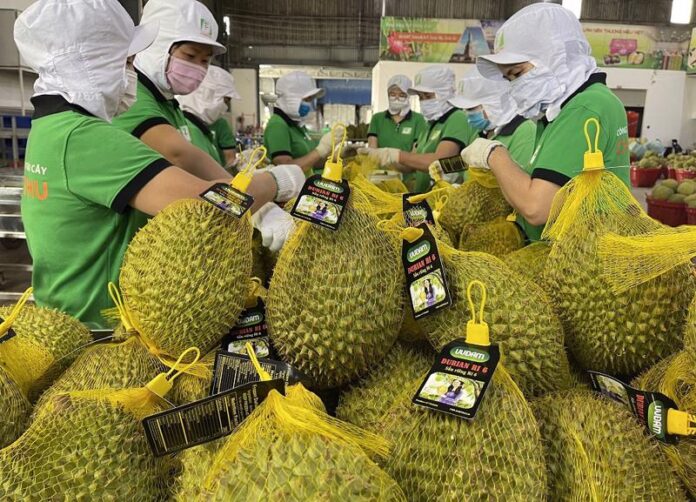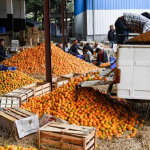Frozen durian exports to hit $500 million in 2024
Commenting on durian exports, the Import-Export Department (Ministry of Industry and Trade) stated that the “king of fruits,” durian, has significant export potential as new markets continue to place orders. “Recently, South Korean partners officially imported durian from the Central Highlands as the region entered the harvest season, even as Thailand, the traditional supplier of durians to South Korea, came to the end of its season,” said Tran Thanh Hai, Deputy Director of the Import-Export Department.
Additionally, on August 19, the Ministry of Agriculture and Rural Development and the General Administration of Customs of China (GACC) signed a protocol on the export of frozen durian. It is understood that last year, China spent about $1 billion importing frozen durian from Thailand and Malaysia. This figure highlights the enormous potential of this market. Therefore, penetrating this billion-people market represents a golden opportunity for Vietnamese durian. A representative from the Import-Export Department affirmed that the demand for frozen durian in China is substantial, and Vietnam’s exports of frozen durian could witness a breakthrough growth in 2025.
Furthermore, the acceptance of frozen durian in multiple markets will contribute to product diversification, reducing seasonal pressure, and simultaneously generating greater added value for the durian industry. Growers will be able to focus more on producing high-quality fresh fruits for export.
Notably, if previously, frozen durian was mainly exported to Thailand and some distant markets like the US and Europe, “currently, some countries in Northeast Asia are also exploring Vietnamese fruit products in general and durian in particular for import. Trading with partners in this region allows exporting enterprises not only to benefit from tariffs but also to reduce transportation and logistics costs compared to traditional markets such as the EU and the US,” analyzed Dang Phuc Nguyen, Secretary-General of the Vietnam Fruit and Vegetable Association.
According to estimates, durian exports may reach about $3 billion this year. Specifically, in 2024, exports of frozen durian alone are expected to bring in $400-500 million in revenue – an impressive feat for the first year of entering the Chinese market, and it is projected to soon join the list of billion-dollar agricultural export items in 2025.
Vietnamese durian needs to meet multiple standards to enter China
As such, frozen durian has officially been granted access to the Chinese market, creating enormous opportunities for the Vietnamese durian industry and promising a boom in trade turnover in the coming years.
Per the Protocol on the requirements for inspection, quarantine, and food safety of frozen durian from Vietnam to China, frozen durian (Durio zibethinus) includes whole durian (with husk), crushed durian (without husk), and durian aril (without husk), originating from fresh, ripe durian grown in Vietnam.
Notably, the protocol stipulates numerous standards and conditions that must be met for Vietnam to export frozen durian to China.

Durian is currently the fruit with the highest export value.
Accordingly, frozen durian must be hand-picked to eliminate rotten or damaged fruits and ensure no foreign metallic contaminants.
Additionally, the raw material for frozen durian exported from Vietnam to China must originate from durian orchards registered with the Vietnamese authorities.
Moreover, Vietnam will inspect the facilities for producing, processing, and storing frozen durian for export to China and introduce qualified enterprises to the Chinese side. These enterprises must be registered with China, implying that only registered companies can export their products to China.
Furthermore, the packaging material for frozen durian exported from Vietnam to China must be clean, hygienic, unused, and compliant with food safety and plant quarantine requirements.
Throughout the storage and transportation process, frozen durian must meet the standards set by the International Food Standards – “Code of Hygienic Practice for Frozen Foods” (CAC / RCP 8-1976).
Consequently, the packaging facilities for frozen durian must satisfy the requirements for food safety, packaging procedures, traceability, and Hazard Analysis and Critical Control Points (HACCP). Additionally, there are specific requirements regarding freezing capacity and cold storage.
Currently, China accounts for over 93% of Vietnam’s total durian export turnover. Understanding market trends will enable Vietnam to increase its durian export turnover.
It is projected that the demand for durian in the Chinese market will continue to rise in the future due to the growing popularity among consumers. Although there are no precise figures on the annual durian consumption of Chinese citizens, it is evident that durian is highly favored, especially in major cities like Beijing, Shanghai, and Guangzhou.



















